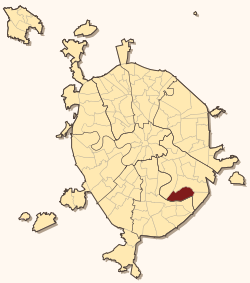Maryino District
| Maryino District | |
|---|---|
 Location of Maryino District in the City of Moscow | |
| Coordinates: 55°45′54″N 37°41′29″E / 55.76500°N 37.69139°ECoordinates: 55°45′54″N 37°41′29″E / 55.76500°N 37.69139°E | |
|
Residential buildings, Maryino District | |
 |
.png) |
|
| |
| Location | |
| Country | Russia |
| Federal subject | Moscow |
| Statistics | |
| Area | 11.917 km2 (4.601 sq mi)[1] |
| Population (2017 est.) | 252,597 inhabitants[1] |
| Density | 21,196.36/km2 (54,898.3/sq mi)[2] |
| Time zone | MSK (UTC+03:00)[3] |
| Official website | |
| Maryino District on WikiCommons | |
Maryino (Russian: район Марьино) is a district of South-Eastern Administrative Okrug of the federal city of Moscow, Russia. Its area is 11.917 square kilometres (4.601 sq mi)[1]. Population: 252,597 (2017 est.); 247,479 (2010 Census);[4] 206,388 (2002 Census).[5] It is the most populated district of Moscow.[4]
History
In the early 12th–13th centuries, the area of the modern district was where the village of Maryino stood near Chaginskoye Marshes. The district's name dates back to that village, which itself was called after Mariya Yaroslavna, mother of Tsar Ivan III, who founded the village.
In 1898, Lyublino Aeration Fields were built in this area. The fields occupied the territory of over one thousand hectares. In 1911, Moscow canalization system won a Golden Prize in Brussels. After the Kuryanovo Aeration System had been built in 1978, it was decided to use the territory of the former Lyublino Fields for construction of new apartment buildings. As Moscow grew in later years, the territory was incorporated as Maryino District of Moscow.
In 1996, two metro stations were opened in the district.
References
- 1 2 3 "General Information" (in Russian). Maryino District. Retrieved March 27, 2018.
- ↑ The value of density was calculated automatically by dividing the 2017 population estimate by the area specified in the infobox. Please note that this value is only approximate as the area specified in the infobox does not necessarily correspond to the area of the entity proper or is reported for the same year as the population.
- ↑ Правительство Российской Федерации. Федеральный закон №107-ФЗ от 3 июня 2011 г. «Об исчислении времени», в ред. Федерального закона №271-ФЗ от 03 июля 2016 г. «О внесении изменений в Федеральный закон "Об исчислении времени"». Вступил в силу по истечении шестидесяти дней после дня официального опубликования (6 августа 2011 г.). Опубликован: "Российская газета", №120, 6 июня 2011 г. (Government of the Russian Federation. Federal Law #107-FZ of June 31, 2011 On Calculating Time, as amended by the Federal Law #271-FZ of July 03, 2016 On Amending Federal Law "On Calculating Time". Effective as of after sixty days following the day of the official publication.).
- 1 2 Russian Federal State Statistics Service (2011). "Всероссийская перепись населения 2010 года. Том 1" [2010 All-Russian Population Census, vol. 1]. Всероссийская перепись населения 2010 года (2010 All-Russia Population Census) (in Russian). Federal State Statistics Service. Retrieved June 29, 2012.
- ↑ Russian Federal State Statistics Service (May 21, 2004). "Численность населения России, субъектов Российской Федерации в составе федеральных округов, районов, городских поселений, сельских населённых пунктов – районных центров и сельских населённых пунктов с населением 3 тысячи и более человек" [Population of Russia, Its Federal Districts, Federal Subjects, Districts, Urban Localities, Rural Localities—Administrative Centers, and Rural Localities with Population of Over 3,000] (XLS). Всероссийская перепись населения 2002 года [All-Russia Population Census of 2002] (in Russian). Retrieved August 9, 2014.
External links
- Official website of Maryino District (in Russian)
- Official website of the local self-government of Maryino District (in Russian)
- Nashe Maryino (Our Maryino), unofficial website (in Russian)
- Maryino District news (in Russian)
- Birds of Maryino District (in Russian)
